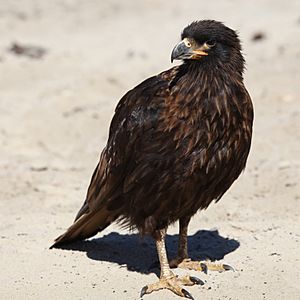Striated caracara facts for kids
Quick facts for kids Striated caracara |
|
|---|---|
 |
|
| Conservation status | |
| Scientific classification | |
| Genus: |
Phalcoboenus
|
| Species: |
australis
|
The striated caracara (Phalcoboenus australis) is a type of bird of prey from the Falconidae family. In the Falkland Islands, people call it the Johnny rook. This name might come from the Johnny penguin, also known as the gentoo penguin.
Contents
What Does the Striated Caracara Look Like?
Adult striated caracaras have feathers that are almost black. Their legs and the skin around their eyes (called lores) are orange. They also have cool silver stripes on their necks.
When they are born, chicks are covered in soft, reddish-brown fluff. They lose this fluff after their first feather change, called a molt. Young caracaras, known as juveniles, have brown feathers with reddish-brown stripes on their neck and chest. These stripes get darker as they grow older.
They get their full adult feathers when they are about four years old. However, their beak doesn't get its final adult color until they are five years old.
Where Do Striated Caracaras Live?
These birds breed on islands along the coast of Tierra del Fuego. They also live in the Chilean fjords and on the outer islands of the Falklands. It's hard to count all of them on the mainland. But the Falkland Islands are thought to be where most of them live.
Long ago, they might have lived on East Falkland. Today, striated caracaras only breed on the outer islands. They like to live near colonies of penguins and albatrosses.
Striated Caracara Behavior
What Do Striated Caracaras Eat?
The striated caracara is mostly a scavenger. This means it eats dead animals. They often feed on dead seabirds and dead sheep. They also eat leftover food scraps.
Small creatures without backbones, called invertebrates, are also a big part of their diet. They dig up kelp fly larvae from seaweed washed ashore. They also eat beetles and earthworms found in grassy areas.
Sometimes, striated caracaras will hunt weak or hurt animals. This includes young seabirds and newborn lambs. Because they sometimes prey on lambs, sheep farmers have not always liked them.
Striated Caracara Reproduction and Nesting
Striated caracaras build their nests on the ground. They also nest in tall grass clumps or on cliff ledges. The female bird usually lays up to four eggs.
They time their hatching so that chicks are born during the nesting season of seabirds. This makes sure there is plenty of food for the young caracaras. Once the chicks are old enough to fly, they leave the nest and join groups with other young birds.
Status and Conservation Efforts
In the Falkland Islands, there are about 500 breeding pairs of striated caracaras. Both young and adult birds are usually not afraid of people. They often don't even react when humans come near them.
In the past, conflicts with sheep farmers caused their numbers to drop a lot. But now, the people of the Falkland Islanders are working to protect them.
Gallery
-
A young striated caracara eating a dead gentoo penguin chick
See also
 In Spanish: Carancho austral para niños
In Spanish: Carancho austral para niños








